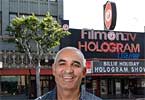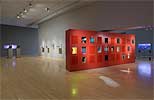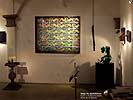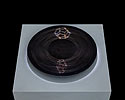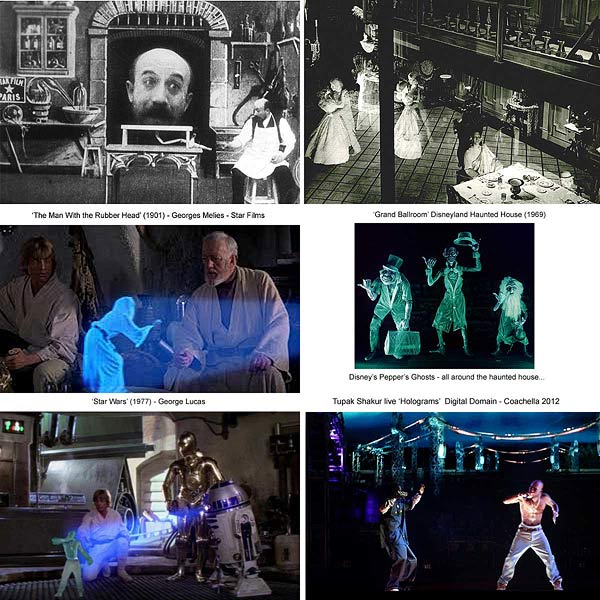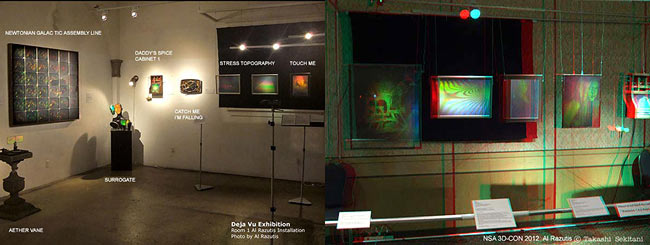'3D - The Last Dance' - Two Case Studies
Al Razutis 2020
"We can understand the term '3D' to mean what it says, although some people only apply this to stereoscopy and binocular vision ('stereo 3D') unwilling to understand or accept what is different in 'holographics' which doesn't rely on how many eyes see what and expresses all 'D'. In our culture, and the cultures of fantasy imagineering, in Hollywood and in theatres, '3D' is a product, a career, a conceit residing in theme parks, block buster movies, and inventors' basements. It's a brand and it's a misnomer because everybody knows that reality is made of '4D', that's four, not three, because everything real is in fact 'moving'.
This essay then focuses on what's left of the culture and exhibitions of 3D as it pretends to the arts in 2018 Los Angeles at LACMA at its 3D: Double Vision' exhibition, or portends an end, with nothing left to show or do in Vancouver after 'Deja Vu' 2010, except to turn the lights out, the city now having forgotten what it was while it vanished into its own 'VR' while following the pretenses of others." (A.R.)
This essay concludes with a re-evaluation of the aesthetic and cultural principles which governed this evolution of stereoscopic film art of the independent kind and especially as it pertains to today's media culture and near-absence of this art form from the fine arts and their institutions.
Where were you in 2018?
"3D of any kind was not created or initially envisioned as art" (AR)
-- But that would come later and so this story is told
Try LOS ANGELES - c. 2018 -- 'It's not called the industry for nothing':
If we're talking about '3D in LA' in the year 2018 it is appropriate to include what passed for 'holography' in Hollywood that year, according to the LA Times that is. (My author's comments appear in red.)
"Resurrecting dead entertainers:
"For $20 a ticket, guests will see entertainers like Holiday, Jackie Wilson and Bernie Mac resurrected by the same technology that brought Tupac Shakur to Coachella in 2012 and saw Michael Jackson moonwalk at the 2014 Billboard Music Awards.
"An heir of the Leventis-David Group, which made its fortune bottling Coca-Cola, David got into the hologram business in 2014 when he founded Hologram USA and purchased the patent for the technology used for Shakur's Coachella 'performance.' Since then, he's invested tens of millions of dollars -- and fought several lawsuits -- on his quest to dominate the business of resurrecting dead entertainers."
My editor's comment: Resurrecting dead entertainers. On Hollywood Boulevard! Besides the 'Hollywood Wax Museum', what's not to like about such a worn out LA subject?
But there is more... in the form of office curios available for the holidays!
In 2018, another Kickstarter 3D invention showed up on the block! "The Looking Glass"
This is what passed for 'holographic display' on Kickstarter, then peddled big time on the web with ads, with company trolls dissing anyone who might question them. I know that for a fact, I was dissed too for objecting to their use of 'holography'. Yes, that's my comment in red. Calling itself holo it was... But half a million bucks haul for a 50K goal ain't bad as far as gaming people with fake holography.
This Looking Glass volumetric display advertising got me so angry that I had to pen another chapter on 'Alice' -- Alice in the Looking Glass World
Let's not forget where we are, nor that 'industry' and its 'culture'.
------------- Page Top -------------
The Last Dance - CASE STUDY #1 - '3D: DOUBLE VISION'
Let's say you have a BIG public art museum, like the Los Angeles Country Museum of Art (LACMA) in the Wilshire district, next to the La Brea Tar Pits that contains bones from eons ago and some cleverly arranged light posts nearby... and you want to show 'what happened to 3D'... while there's still people around who remember it...
So you hire a curator Britt Salvesen, with a PhD in Victorian Stereography (when stereo 3D cameras, viewers, everything stereo 3D were 'big'), find a corporate sponsor like Hyundai and some rich donors to pay for everything, and put on this show "3D: DOUBLE VISION" in July 2018, with lots of examples of '3D stuff' in it, a show which the art critic Christopher Knight of your very large and influential newspaper the Los Angeles Times would pan (as being largely inconsequential)...
Yes, the 'LA 3D Club' and other stereo orgs were on board as resources, as were some 3D tech providers. The local 'buzz' was out, those not included in the show organized their own (small) show in a West LA gallery. However, the LACMA show came with 'big budget', pedigree and 'the history of 3D', meaning plenty of examples of stereoscopes and their image pairs from a previous century... And it broke NO NEW GROUND, acting like a last dance to an evening of 'favorite hits', before the lights in the auditorium went out.
A 'shrine' to the Victorian Stereoscope? In this show it was front and center.
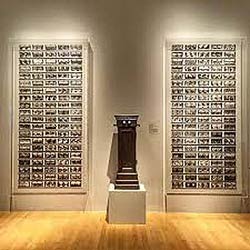
Let me be clear about something, and to quote myself: "Stereoscopic 3D is NOT 'full 3D', it is the psychological and perceptual 'experience' of 3D (height - width - depth) which occurs through 'stereopsis' (the fusion of binocular images into one image) in the brain. The stereoscopic 3D image contains NO vertical parallax (you can't 'look over or under' the image), contains only horizontal parallax owing to the fact that it is comprised of two views by horizontally separated 'eyes'. It is therefore the illusion of 3D which has become the acceptable replacement of three-dimensional reality in our culture of representations."
And with that, I say that the show's title is a 'misnomer'.
Note: How many times are exhibitions of paintings, sculptures, video or film introduced with a "history" and a "what is it" component of their shows? Never. But in 3D, as in holography, curators and presenters seem to feel obliged to educate us before showing us the art.
To put this show into perspective, meaning scale, proportion, and spatial definitions, here are some installation images. As is clearly evident, the show was presented with a number of individual exhibits that focused on an aspect of what the curator had in mind: a 'survey' of 3D from the Victorican era all the way to the present with her selections of topics front and center.
It's a clean layout, it is touted as 'interactive', but it's really a small slice gleamed from a hundred plus years of stereoscopy. And the selections themselves are curiously absent of contemporary authenticity. It's like a walk in the 'playground of illusions of 3D' where some kids 'toys' have been left behind...
Caveat: I never saw the show in question in person. This post and commentary is less about the specific contents of the show and more about the fine arts community and how it does things relating to this final dance of 'what is 3D' in the capital of FX illusionism.
But the pictures are telling, as are some of the works featured in them, not to mention the preponderance of 19th century Victorian stereo hardware which the curator specialized in as per her PhD Doctoral thesis.
'What is 3D and what is not 3D' gets confusing when an exhibition crosses the lines between fact and some questionable assertions. To this question and answers I refer the reader to my 'APPENDIX B', which takes up the case of some of the works in terms of their questionable place in this show.
And my response generally is? Well, I'm giving it consideration and telling it throughout. But in overview I do like quoting Christopher Knight who reviewed this show for the LA Times who says: " As our tempestuous digital epoch proceeds, however, what might come of 3-D for art remains to be seen. So far, the answer appears to be not so much."
It's inevitable that someone like me would spot this and exlaim: "What the hell is that ugly nursery playpen 'red thing with holes for displays' doing in this show?" 'Oh, that's the Michael Snow piece selected for the show' comes a reply. This is piling on names and absurdities in the name of 'conceptual'. It's inevitable then that we'll hit the 'strucuturalists' soon...
-----------------------------------
3D experimental films by Ken Jacobs and Lucy Raven
Two films shown at 'Double Vision' are briefly reviewed here, 'The Surging Sea of Humanity' by Ken Jacobs and 'Curtains' by Lucy Raven.
Note: As for the early "3D films" of Ken Jacobs, circa 1997 (and I saw this work in Paris), I have been previously outspoken on the fact that he made his 3D film career using 'Pulfrich Effect' in his 3D works, a technique which I consider a fake and incomplete version of anything '3D'.
--- More on the 'Pulfrich Effect' is contained in my APPENDIX B, under the heading "When 3D is not 3D".
Thus, it's rather incredible to me that curators and scholars in 3D art sometimes display a confusion as to 'what is stereoscopic 3D?', 'what is 3D', and 'what is a hologram?'. Many times this confusion is enhanced by '3D insiders' (and artists) who are promoting their own works and styles, and which cutaros (like Salveston) turn to for 'advice'. For someone like me outside of both fields (I'm not a paid museum curator, I'm no longer an academic) to have to clean this up says something about the 'mess' and the level of scholarship in both.
On its own, THE SURGING SEA OF HUMANITY by Ken Jacobs is more interesting than the anaglyph conceptual work (a very slow left-right image convergence - then crossing to pseudocsopic reversal to complete the film) found in Lucy Raven's film CURTAINS presented with laser projection in hi-res 3D.
It's annoying to me to see that Jacobs' film is presented in a show that celebrates binocular or stereoscopic 3D viewing and 'stereopsis', the fusing of a '3D image' from discrete separate channels 'into one'. This annoyance is increased when reading the curator Britt Salveson's comments on the nature of '3D' as stated in interview with the museum publication (cited below): "To experience 3D is to engage with questions about the nature of perception, the allure of illusionism, and our relationship with the technologies that create such images. The artworks in 3D: Double Vision function by activating binocular vision -- the process by which our brains synthesize the information received by our two eyes into a single, volumetric image. To me, it's magical to realize that what we perceive as solid objects are actually virtual images. "
In his film, Jacobs plays with the 'concept of 3D' perception, plays with instilling 'shifts' in 2D image texture from measured displacements of an stereo image pair, with no '3D stereo' intended or in mind except as a historical referrent where 'history' is merely added to the formal play. He situates this structural film exercise 'within stereoscopic photography' (the film image is derived from an old last century stereo pair which is displayed at the end) and firmly within a range of 'structual film optical fx'. Thus he comes out being 'both a structural' and conceptually a '3D filmmaker'. I take a different view, that his work is minimalist structuralist film' to the very end, and he's not much of a '3D film' maker, but like Michael Snow in holography, one that pretends by way of conceptual 'conceit'. However, it is a successful strategy -- Jacobs is one who keeps being shown in 3D art exhibits by curators mystified and similarly attracted by his conceptual game. His work certainly struck a cord with L.A. art critic Christopher Knight who found it to be one of the few redeeming things in the otherwise uninteresting art show.
To view this 11 minute film by Ken Jacobs, visit VIMEO with this link to 'The Surging Sea of Humanity'
To view a 5 min. excerpt (installation view) from the 50 minute film by Lucy Raven, visit YOUTUBE with this link to 'Curtains'
In both films there is hardly any (stereoscopic) 3D to be seen or to speak of. Sure, in Lucy Raven's film a stereo 'pair' converges long enough so we can 'fuse a 3D image momentarily', but really 'so what'? The image and scene is banal, uninteresting. Sure, in Ken Jacob's film the two images 'squirm', 'shift', 'rotate' vis a vis it's paired twin, and the textures are 'exciting', and this constitutes (to some) 'avant-garde' film. But really, what is it doing in this show except providing conceptual structural film 'comment' by using a old stereoscope image pair? And that's what I state now and sign it 'A.R.' and why I know the lights on this will 'go out'.
-----------------------------------
My review of the LACMA show is based on the evidence provided from the statements and documentation of others and with these concerns:
1. The five categories cited by Christopher Knight (in his revue, linked below) appear to be an attempt to tell the history, the story of 3D in a manner of selective inclusion / exclusion, or a revisionism based on the curator's personal preferences. So I suppose we have to read her Doctoral thesis (dissertation) to get the full picture of where this show was coming from. But it's clear this show has 'Victorian' roots, and the manner of presentation here is bordering on academic, sterile, conceptual and 'clean'.
2. I ask "What is it about 3D shows, and holographic display and art shows in galleries and museums that resort to the 'how was it done', 'what is the science behind hit' forms of introducing this art to a general public?" I think by now this is an over played hand. Disneyland does a better job of enticing the public with their fake holograms and their Haunted House! Why compete? Focus on the arts.
3. What is missing here in the LACMA show is reference to stereoscopic film done in a 'full stereo manner', not as a 2D structural film excercise or a conceptual play with anaglyph stereo views 'slowly converging'. Even the inclusion of a fractal CGI film work by someone like John Hart (whose work has been seen extensively across 3D circles) would have been more interesting than Jacobs' conceptual pretense to 3D which I have criticized elsewhere.
4. Where is true holography in this show? Not in the multiplex hologram represented. That's a 'subgenre' of holography and holographic art, not even close to being representative, unless one is still confusing holographics with 'Pepper's Ghost' projections (from the Victorian era), or with a dead Tupac at raves appearing 'as a fake hologram', confused by and with all things that holography is not.
The question remains, 'how can we make this conflation resulting in misrpresentation stop?' Well, we start by responding to it.
---------------------------
| "With 3D: Double Vision, LACMA does a disservice to the public, the artwork, and most of all itself as a competitor in a rapidly changing landscape of artistic priority and mass appeal. While this exhibition may have seemed cutting edge 10 years ago, today it showcases in danger of dismaying and/or confusing visitors prone to fall in love with the Infinity Rooms and Happy Places of the 'must-see,' limited run milieu. And this is sad. If LACMA spends copious donor funding and corporate sponsorship dollars (in this case Hyundai) on lackluster demonstrations of art and technology, they will not only fail to compete with trendy, pop-up installations, but they will run the risk of disenfranchising a novice public who would rather spend their money on attractions with greater social media equity." -- LACMA Loses Vision In 3D by James L. Chapman, August 16, 2018, in Cultural Weekly |
Ouch!
Have there been any more art shows touting "the first American exhibition to survey a full range of artworks, dating from 1838 to the present, that produce the illusion of three dimensions. " in LA, in SF, or anywhere on the west-coast, ever since?
Go ahead and point me to them.
The arts review by art critic Chistopher Knight for the LA Times is at Review: With 'Double Vision' at LACMA, 3-D art strives to find a new dimension
------------------
Let's be fair: here's the interview with the curator Britt Salvesen who is a bona fide schollar PhD in stereoscopic history, and as curator is by tradition the chief explainer, defender, apologist for any art show in any big museum. (Photo of Ms. Salvesen and exhibition sponsor, museum administrator.)
https://unframed.lacma.org/2018/07/05/interview-curator-britt-salvesen-3d-double-vision
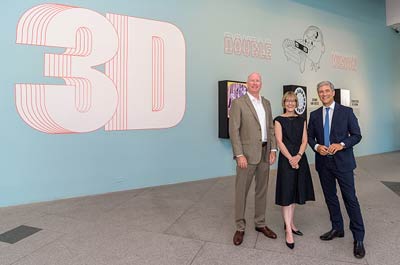
MORE RESOURCES - LINKS:
LACMA's New Interactive Exhibit Explores The Art and Illusion of 3D
------------- Page Top -------------
The Last Dance - CASE STUDY #2 - 'DEJA VU'
Visit a page on 'Deja Vu' at its momentary appearance in Vancouver, Canada, October 2010:

BACKGROUND:
"In October 2010 an exhibition of pioneering works by Vancouver artists-holographers Al Razutis, Melissa Crenshaw and Gary Cullen was presented 'free admission' (and without government grants or external curators) to Vancouver audiences who largely unfamiliar with what had been created in their city from the early seventies onwards.
"Holography had not been publicly exhibited in Vancouver in an art context since the 1980's (Razutis' last exhibition at SFU Gallery) and had never been exhibited alongside stereoscopic 3D works, history, and related art forms.
"This show presented the two forms of '3D imaging' - stereoscopic 3D photography, and its offshoot lenticular 3D image photography, and holography in its many forms (as art, display, in reflection, interferometric, rainbow, transmission hologram forms) in a manner of relating these forms to each other, not to chart out exclusive domains for any of this work.
"The primary impetus and content behind this show was provided by Al Razutis and Gary and Kari Cullen. They supplied most of the content, the broad technical expertise to encompass holography and stereoscopic 3D exhibitions as both Razutis and the Cullens were 3D - holographics experts and experienced in these fields since the 1970's. Furthermore, overnight security was provided by Al Razutis and extensive photo and label documentations for the exhibition was done by Gary and Kari Cullen. Opening and closing night catering by Anne Popperwell and friends.
"The show was attended by hundreds of this and next gen people, some familiar with this medium or the artist, some new. It was a week long event, didn't appear in the news, was advertised on social media or by word of mouth. Then the show vanished, and throughout the following decades there has hardly been a 'murmur' about these 3D works or if they will ever be seen in Vancouver again. Vancouver 3D pioneering has vanished once again from the cultural radar, until the next gen proves the amnesiacs wrong." (A.R.)
- > Deja Vu - Holographic Art and 3D Display Exhibition, 2010
- > 2012 update - Razutis at NSA exhibition
----------------------------------
CURATOR'S STATEMENT: 'REDEFINING 3D IN SPACE AND TIME: FROM DAGUERRE TO HOLOGRAPHY TO HD 3D FRACTALS'
"Imagine an exhibition where the past of the 1800's and 1900's arrives in the same time and place as holography and stereoscopic HD 3D, where Daguerre's 3D photos, holography, and 3D fractals can be experienced, as if 'informing' each other's content and forms. This exhibition, rather than being a conflation of history, suggests our capacity to embrace 'vision and desire to see more' implicates a thirst for the intangible made real through imaging art and technologies. This exhibition hopes to stimulate new imaginations of the real, and new works in light, and perhaps some new directions will be based on the startling juxtapositions and insights found in this show.
"The artists are the curators of 'Deja Vu',
and while the exhibition is fleeting and held only for one week,
and the locale is Vancouver, Canada, where many of these works
in holography, stereo 3D, lenticular 3D, stereoscopic 3D video
were pioneered and created, the conjunction of all these previously
disparate moments in time and space has found a 'moment in time'
where some clarity and a insight of the future can arise."
- Al Razutis (2010)
FILMS AT DEJA VU -- Hart, Oldaker, and Razutis

An 'evening of 3D films' presented in cross-polarized stereoscopic 3D manner was a featured item of the exhibition opening night, and closing night for Deja Vu - Holographic Art and 3D Display Exhibition, held in Vancouver in 2010.
3D films presented were the magnificent computer generated fractal film 'Fractal Odyssey' created by 3D filmmaker John Hart and computer programmer Jerry Oldaker, as well as the 'classic analog 3D works' by artist filmmaker Al Razutis which were compiled from excerpts from his internationally screened shorts.
- > Analog 3D classics by Razutis from the 1990's
For a anaglyph 3D film interpretation by A.R. of the opening of 'Deja Vu' on You Tube, visit:
Ensalada Deja Vu - 'para llevar' 6 min. - anaglyph 3D by Al Razutis 2019

... and now to cut to the chase and re-state what I first wrote in Appendix C, because it merits repeating, and for the record:
CONCLUSION:

These are the components, this is how it starts: "This essay concludes with a re-evaluation of the aesthetic and cultural principles which governed this evolution of stereoscopic film art of the independent kind and especially as it pertains to today's media culture and near-absence of this art form from the fine arts and their institutions.
"We know that stereoscopic 3D followed two parallel paths, one scientific and the other novelty-oriented entertainment medium. So any discussion of the 'aesthetic and cultural principles' must contend with the question, 'which culture are we interested in? the popular culture or the fine arts culture of high art?' They are not interchangeable and in fact operate independently of one another.
"The experience of 3D displays, gimmicks, novelties, toys and advertisements in popular culture is covered by other publications, as are the commercial exploitation of stereoscopic 3D in mass moview that used 3D to enhance its horror or sci fi or adventure content by making the experience more 'immersive', as long as one was wearing the 3D glasses designed for the show.
"My interest is in what happened to '3D art' - was it abandoned by curators and museums and galleries in favor of showings of 'established artists' whose pedigree and marketability was proven in other mediums and who had decided to experiment or dabble in 3D for a limited time only?
"Certainly, this is what has happened here with '3D: Double Vision' showing at LACMA in Los Angeles, and this is commented on by the art critic Christopher Knight in his revue of the show.
"This practice of featuring only established artists working in 3D follows the practice in holographic art displays of the last decades: only established artists are exhibited, and the medium itself, whether 'stereoscopic 3D', or 'holography', or variants of them, is now backgrounded simply as a 'craft' and not an art, since this medium's "art" and "aesthetics" have rarely been accepted by curators.
"One must then conclude that for the most part 'there is no 3D art', 'there is no holographic art' that is accepted by major museums and their curators as a coherent theory and practice that can inform their decisions, that is discernable and defensible in the fine arts. There is only "art made by artists who decided to use 3D or holography as a medium, not as an art in itself for their expressions". The 2018 LACMA show made clear that established artist who may 'dabble in 3D' or 'experiment' are preferable over those unknowns who may have made a career of it. The inclusion of Bruce Nauman as a 'holographic artist' (who never really made the holograms but posed in front of the Conductron Corp. pulsed laser camera, then put his name to them) or Ed Ruscha (who also didn't make his hologram) are to be expected, especially since they were also used in one of the last large exhibitions in the East, like 'Pictures From The Moon' which is reviewed in another essay I wrote: 'Art and Holography 3 - Pictures From The Moon'
"Now that this practice of curating and exhibiting name artists using 3D (to incude stereoscopic and holographic forms of it) has become 'standard', repeated on both N. American coasts, we can assume that when these old guys and gals die so will this practice of 'experimenting' and 'showing some 3D once in a while' die with them.
"The artist Michael Snow (who turned 90 this year) was in the LACMA '3D: Double Vision' show in the form of some large 'toy like with cubby holes red sculpture' that sat in the middle of its room and was largely ignored in the art reviews. But the story of Snow and Canada, the story of the history of holographic arts in Canada, was best mis-told by Snow himself. It merits a quote or two from my essay on 'Art and Holography - Part 3' in particular this section which was named 'This is the lasting legacy of Snow's $800 K Expo '86 show of holograms, the last blast from Canada', and for that I'll give it its own box to exist in." (A.R.)
|
5. The lasting holo legacy in Canada doesn't even get praise... Coming across this Michael Snow quote in the Globe and Mail 2012, a publication that keeps touting 'holography' as if it were a projected image of a rocker on stage... here's what Sarah Nicole Prickett ('Special to the Globe and Mail', Aug. 24 2012) wrote in her article. Consider this an 'official Kanadian version of holo history': "Snow, now 82, seminalized holograms in Canada. My friend Danielle Forest, an art-history grad and project manager at New York's Nyehaus Gallery, wrote her masters thesis on holograms; Snow told her he'd never seen them in an art context before Vancouver's Expo '86, when he was given $800,000 to create a whole holographic world." This is the lasting legacy of Snow's $800 K Expo '86 show of holograms, the last blast from Canada: "It was as if, in discovering a magical technique, he felt relieved of having to make anything new. That, or he wanted to turn the realest-seeming objects into holograms, as if to prove that everything we need is illusory. I mean, his '86 exhibit was just anti-fantastic to the point of total banality: tableau after tableau of entirely common, totally correlated objects, with some women thrown in for good measure. "'If it isn't interesting in real life,' wrote a Vancouver Sun reviewer, 'it isn't interesting as a hologram.'
If not impressed, see Barrie Bolton's Revue of this show in 1986 -- he trashes it and writes from a position of knowledge and experience. No mention is made at all in this 'Canadian holo history' of my works or my 'Visual Alchemy', a solo holo show that was toured across Canada almost a decade earlier than Expo 86. Written out of history. Then another history is re-produced in 'museums' and further curated shows. Marcel Duchamp got away with stuff like this. Never expected it from 'back home'. I hope we all got that. |
"In cultures where artists produce mainly commodities to be bought and sold again and again the idea of novelty is never a winner. There's always something 'younger', 'newer', 'more exciting'. This ticket of novelty and fantasy was the 'story of the 3D arts' for a long time, over a century. When this story runs out of ideas, out of novelties, which is about now in our culture, it's when the 'lights go out and the dance is over'.
"3D - the last dance" it was, but of course it's all waiting to be reinvented." -- Al Razutis, 2020
A Post Script to all this:
The last big show from Canada that 'vanished', but the Canucks don't seem to care!
Lost in Time and Space -- Al Razutis, 1992
------------- Page Top -------------
Three Appendices for the record
APPENDIX A
Razutis's background in 3D - and his historical attempts to generate interest in Vancouver with public shows conducted independently and with others.
If you can't wait for the draft, here is a technical bio of Razutis in holography and 3D:
http://www.alchemists.com/visual_alchemy/holographics_resume_razutis.html.
A list of stereoscopic 3D films and related works by Al Razutis is available here:
http://www.alchemists.com/visual_alchemy/raz-3dfilms.html.
And just so you know that the author is not a beginner in holography, and holographic art, a complete list of his published and exhibited holograms is here:
http://www.alchemists.com/visual_alchemy/raz-holo.html.
If you would like the 'long version about everything 3D' that Razutis and author historian Ray Zone talked about, which ended up in his book, visit:
Interview: Ray Zone on Al Razutis - Stereoscopic 3D film art and computer desktop editing - publishing - August 9, 2010
and for a shorter version, which is 'Chapter 23' of the book '3-DIY' by Rayzone download this pdf:
Al Razutis: A Complete 3D Artist
That's enough for now to keep us busy.
-----------------------------------
APPENDIX B
"When is 3D not 3D?", and "When is a hologram not a hologram?" and other trivia questions, among them:
SCRATCH-O-GRAMS are featured in the LACMA 3D: DOUBLE VISION show with a series of 'Platonic Solids' by artist Tristan Duke, as seen on turntables on plinths. These hand-drawn diffraction gratings depicting wire-frame versions of solids, I have concluded in more than one essay are not holograms.
My definition of holography comes from the inventor of holography, Dennis Gabor and includes the ideas of founding giants of optical holography Y. Denisyuk, E. Leith & J. Upatnieks, and L. Cross.
It is unclear to me why scratch-o-grams, including workshop, by artist Tristan Duke were included in this exhibition, as it is unclear why Michael's Snow's colorful nursery-theme sculpture was included in '3D: DOUBLE VISION', or why Ken Jacobs' pulfrich 3D film was included, yet a number of other forms (3D VR, AR, Holographic Art, Lenticular 3D art) were excluded.
To differentiate what happens in holography compared to 'scratchograms' let's take a closer look at papers from the advocates of scratch-o-grams, William Beatty and Nils Abramson, which are referenced below.
It is unclear to me why scratch-o-grams, including workshop, by artist Tristan Duke were included in this exhibition, as it is unclear why Michael's Snow's colorful nursery-theme sculpture was included in '3D: DOUBLE VISION', or why Ken Jacobs' pulfrich 3D film was included, yet a number of other forms of 3D (3D VR, AR, 3D Holographic Art, Lenticular 3D art) were excluded.
For a gallery of pages from a chief promoter of scratch-o-grams William Beaty see his web pages at 'Abrasion Holography', Hand-Drawn Holograms 1995.
For a scientific paper on 'scratchograms' by Nils Ambramson (also a proponent of these and calling them 'holograms') download his paper 'Incoherent Holography' in PDF file format.
Download / view 16-second MP4 video of scratch-o-gram display in exhibition: Hand Drawn Hologram - Scratch-o-gram - Video
Nevertheless, I stand on what I said before: "Scratch-o-grams are not holograms", and for the answers to 'what is a hologram' one can refer to the inventor of holography, Dennis Gabor as per his Nobel Prize Lecture of 1971 which you can download in PDF HERE
MULTIPLEX HOLOGRAMS are not 'true and complete holograms' in the original sense and definition / theory of the word, for the simple reason that they lack 'vertical parallax' in their depictions and playback, and are holograms of 2D film strips shot of a horizontally rotating / moving subject, like in 'stereoscopic 3D' movies, which you all know and have seen. They are holograms of photographs and were invented (by L. Cross) as a short cut to motion picture holography. Their presence in a holographic and stereographic exhibition must be explained, because both in a historical sense and in a technical sense they are closer to what is terms 'stereograms' than 'holograms'.
Their presence in this LACMA 3D DOUBLE VISION exhibition is most welcome. They are after all a perfect 'bridge' between pure stereoscopic 3D and pure holographic movies, and a world-famous venue like LACMA serves to focus public attention on all things 3D.
However here, and it's a disappointment to me, that the one hologram shown in the entire exhibit, a 120 degree white-light multiplex / integral from 1976, a short movie "Striding Crawling" by Simone Forti (and Lloyd Cross) appears independent of context, and is only contained within only a few seconds of action, a portion of the full cylinder which was recorded and made by Forti and Cross in 1976.
For further examples of multiplex hologram collaborations between Simone Forti and Lloyd Cross in the 1970's, visit: Lloyd Cross and Simone Forti Holograms.
--- For the record, and for those folks adoring their 'Looking Glass' volumetric display 'cubes' and thinking 'hey that's holographic!', " a hologram is defined as a recording of both the amplitude and phase characteristics of all things within a 'scene' or a volume of space, which is typically populated with reflecting objects moving around or still. If one records the same scene 'photographically, like in 'motion picture' recording, all they record is the 'amplitude' and colours of those scenes, with each frame capturing a increment of movement and 'focused on a 2D film plane'. That should be pretty simple to see how photography and holography differ in fundamental ways that cannot be obscured by sloppy use of language or labels.
To take a closer look and to debunk some 'NYC fakery' -- visit another appendix from my essay on holography and read about "what is a multiplex holographic stereogram?", also called 'integral', or simply 'multiplex':
http://www.alchemists.com/visual_alchemy/art_and_holography3.html#appendix-b
To read the words of multiplex hologram inventor Lloyd Cross and see the creations, technology of 'multiplex holograms' visit the Sharon McCormack Archives Multiplex Printers and Technology page.
PULFRICH EFFECT 3D is not true 3D, and for the explanation I take you on a 'Hollywood Tour'. That this was first 'foisted on FB' will give you an indication as to how it can be read. And how it is contrived. And why I repeat it here for our edification.
(ROLL TOUR, continuing on 'Hollywood Boulevard' and those 'walks of fame')

"WHAT IS IT? What are we talking about here?"
"The Pulfrich effect is a psychophysical percept wherein lateral motion of an object in the field of view is interpreted by the visual cortex as having a depth component, due to a relative difference in signal timings between the two eyes."
---- : https://en.wikipedia.org/wiki/Pulfrich_effect
"What did the TOUR GUIDE BOOK SAY?"
"Because the Pulfrich effect depends on motion in a particular direction to instigate the illusion of depth, it is not useful as a general stereoscopic technique. For example, it cannot be used to show a stationary object apparently extending into or out of the screen; similarly, objects moving vertically will not be seen as moving in depth. Incidental movement of objects will create spurious artifacts, and these incidental effects will be seen as artificial depth not related to actual depth in the scene. Many of the applications of Pulfrich involve deliberately causing just this sort of effect, which has given the technique a bad reputation. When the only movement is lateral movement of the camera then the effect is as real as any other form of stereoscopy, but this seldom happens except in highly contrived situations. It can, however, be effective as a novelty effect in contrived visual scenarios." (Wikipedia)
"Now, for our FIRST STOP -- The Pulfrich Museum!"
"In 1989, Super Bowl XXIII featured a halftime show that utilized the Pulfrich Effect - an illusion caused by placing a dark filter over one eye, which creates a slight delay between the eyes in the visual cortex. Due to this tiny temporal difference, the viewer can perceive depth from sideways movement in a 2-D video.
"Coca-Cola had produced a 3-D commercial that was planned to air during the popular TV show MOONLIGHTING, but a television writer's strike caused the cancellation of that 3-D broadcast. With millions of branded Pulfrich glasses already manufactured, Coca-Cola turned to the big game. The show, entitled BEBOP BAMBOOZLED, included an Elvis impersonator performing magic tricks, and dancers in poodle skirts, and was quite an oddity.
"You can watch the entire half time show here, including the introduction and explanantion of 3-D by sportscaster Bob Costas. So grab some Pulfrich glasses (or just find some old sunglasses and POP OUT THE LEFT LENS) and check it out!"
---- https://www.youtube.com/watch?v=Q5IMFsx-pvs
"Previous peddled pulfrich effect works include those seen in 'LASERIUMS' in the 1970's, the laser having been invented in the 60's, so nobody better claim it was in their light shows, eh?"
"They were all the rage for a while on the US West-coast. Maybe they're playing at the planetarium near us? How about hanging a turn and taking us to 'Griffith Park Observatory & Planetarium' for some fun and some views, eh?"
"Oh those Canadians with their eh's!"
"Pufrich ain't holo, not even full 3D it is. It's 'cardboarded planes in depth', and as the explanations offered it relies purely on a 'psychological effect'. But interestingly enough, 'it is related to laser art and holography', in that holography pioneers such as Lloyd Cross and Jerry Pethick experimented with bouncing laser beams off vibrating acoustically driven mirrors, creating patterns in sync with real time vibration, music, eh?"
The fakery of the 'Pulfrich Effect' masquerading as '3D':
'The Pulfrich Effect',
and other fakes revealed in the arts.
"As for previous peddled pulfrich effect works in art, specifially the "avant-garde 3D films" of Ken Jacobs, this tour guide promised you a visit to the place of fine arts fakery, once shown in Paris (at the Louvre auditorium!), and that's on this page 3D Video Art in France 1997 which talks about Razutis' film tours and mentions Ken Jacobs presention with his 'projector' and 'pulfrich glasses'..." (A.R.)
'Four Takes On the Narrative' - more on Ken Jacobs and 3D, 2022 essay
--------------------------------------
APPENDIX C
Notes, Terms and Clarifications -- To include a glossary of terms, and rationale, clarifications, and conclusion. This is where the final fun is to be had, before the lights go out and we move on to other subjects. And find other 'playmates to dance with in the arts'.
GLOSSARY OF TERMS
(This section is ongoing, depending on what needs clarification first.)
Hologram is easily searchable, tons of papers written about what it is, including the following from the Nobel Laureate inventor of 'holography' Dennis Gabor whose Nobel Lecture I have on my web site at: http://www.alchemists.com/fb/gabor-lecture.pdf
-- to which I add: "For the record, and for those folks adoring their 'Looking Glass' volumetric display 'cubes' and thinking 'hey that's holographic!', " a hologram is defined as a recording of both the amplitude and phase characteristics of all things within a 'scene' or a volume of space, which is typically populated with reflecting objects moving around or still. If one records the same scene 'photographically, like in 'motion picture' recording, all they record is the 'amplitude' and colours of those scenes, with each frame capturing a increment of movement and 'focused on a 2D film plane'. That should be pretty simple to see how photography and holography differ in fundamental ways that cannot be obscured by sloppy use of language or labels. <"
Stereoscopic 3D is also easily searchable. To which I add from the text on LACMA show above: "Stereoscopic 3D is NOT 'full 3D', it is the psychological and perceptual 'experience' of 3D (height - width - depth) which occurs through 'stereopsis' (the fusion of binocular images into one image) in the brain. The stereoscopic 3D image contains NO vertical parallax (you can't 'look over or under' the image), contains only horizontal parallax owing to the fact that it is comprised of two 2D views made by horizontally separated 'eyes' or camera lenses. It is therefore the illusion of 3D which has become the acceptable replacement of three-dimensional reality in our culture of representations."
CONCLUSION:

These are the components, this is how it starts: "This essay concludes with a re-evaluation of the aesthetic and cultural principles which governed this evolution of stereoscopic film art of the independent kind and especially as it pertains to today's media culture and near-absence of this art form from the fine arts and their institutions.
"We know that stereoscopic 3D followed two parallel paths, one scientific and the other novelty-oriented entertainment medium. So any discussion of the 'aesthetic and cultural principles' must contend with the question, 'which culture are we interested in? the popular culture or the fine arts culture of high art?' They are not interchangeable and in fact operate independently of one another.
"The experience of 3D displays, gimmicks, novelties, toys and advertisements in popular culture is covered by other publications, as are the commercial exploitation of stereoscopic 3D in mass moview that used 3D to enhance its horror or sci fi or adventure content by making the experience more 'immersive', as long as one was wearing the 3D glasses designed for the show.
"My interest is in what happened to '3D art' - was it abandoned by curators and museums and galleries in favor of showings of 'established artists' whose pedigree and marketability was proven in other mediums and who had decided to experiment or dabble in 3D for a limited time only?
"Certainly, this is what has happened here with '3D: Double Vision' showing at LACMA in Los Angeles, and this is commented on by the art critic Christopher Knight in his revue of the show.
"This practice of featuring only established artists working in 3D follows the practice in holographic art displays of the last decades: only established artists are exhibited, and the medium itself, whether 'stereoscopic 3D', or 'holography', or variants of them, is now backgrounded simply as a 'craft' and not an art, since this medium's 'art" and "aesthetics' have rarely been accepted by curators.
"One can conclude then for the most part 'there is no holographic art' that is accepted by major museums and their curators as a coherent theory and practice that can inform their decisions, that is discernable and defensible in the fine arts. There is only "art made by artists who decided to use 3D or holography as a medium, not as an art in itself for their expressions". The 2018 LACMA show made clear that established artist who may 'dabble in 3D' or 'experiment' are preferable over those unknowns who may have made a career of it. The inclusion of Bruce Nauman as a 'holographic artist' (who never really made the holograms but posed in front of the Conductron Corp. pulsed laser camera, then put his name to them) or Ed Ruscha (who also didn't make his hologram) are to be expected, especially since they were also used in one of the last large exhibitions in the East, like 'Pictures From The Moon' which is reviewed in another essay I wrote: 'Art and Holography 3 - Pictures From The Moon'
"Now that this practice of curating and exhibiting name artists using 3D (to incude stereoscopic and holographic forms of it) has become 'standard', repeated on both N. American coasts, we can assume that when these old guys and gals die so will this practice of 'experimenting' and 'showing some 3D once in a while' die with them.
"The artist Michael Snow (who turned 90 this year) was in the LACMA '3D: Double Vision' show in the form of some large 'toy like with cubby holes red sculpture' that sat in the middle of its room and was largely ignored in the art reviews. But the story of Snow and Canada, the story of the history of holographic arts in Canada, was best mis-told by Snow himself. It merits a quote or two from my essay on 'Art and Holography - Part 3' in particular this section which was named 'This is the lasting legacy of Snow's $800 K Expo '86 show of holograms, the last blast from Canada', and for that I'll give it its own box to exist in." (A.R.)
|
5. The lasting holo legacy in Canada doesn't even get praise... Coming across this Michael Snow quote in the Globe and Mail 2012, a publication that keeps touting 'holography' as if it were a projected image of a rocker on stage... here's what Sarah Nicole Prickett ('Special to the Globe and Mail', Aug. 24 2012) wrote in her article. Consider this an 'official Kanadian version of holo history': "Snow, now 82, seminalized holograms in Canada. My friend Danielle Forest, an art-history grad and project manager at New York's Nyehaus Gallery, wrote her masters thesis on holograms; Snow told her he'd never seen them in an art context before Vancouver's Expo '86, when he was given $800,000 to create a whole holographic world." This is the lasting legacy of Snow's $800 K Expo '86 show of holograms, the last blast from Canada: "It was as if, in discovering a magical technique, he felt relieved of having to make anything new. That, or he wanted to turn the realest-seeming objects into holograms, as if to prove that everything we need is illusory. I mean, his '86 exhibit was just anti-fantastic to the point of total banality: tableau after tableau of entirely common, totally correlated objects, with some women thrown in for good measure. "'If it isn't interesting in real life,' wrote a Vancouver Sun reviewer, 'it isn't interesting as a hologram.'
If not impressed, see Barrie Bolton's Revue of this show in 1986 -- he trashes it and writes from a position of knowledge and experience. No mention is made at all in this 'Canadian holo history' of my works or my 'Visual Alchemy', a solo holo show that was toured across Canada almost a decade earlier than Expo 86. Written out of history. Then re-produced in 'museums' and further curated shows. Marcel Duchamp got away with stuff like this. Never expected it from 'back home'. I hope we all got that. |
"In cultures where artists produce mainly commodities to be bought and sold again and again the idea of novelty is never a winner. There's always something 'younger', 'newer', 'more exciting'. This ticket of novelty and fantasy was the 'story of the 3D arts' for a long time, over a century. When this story runs out of ideas, out of novelties, which is about now in our culture, it's when the 'lights go out and the dance is over'.
"3D - the last dance" it was, but of course it's all waiting to be reinvented." -- Al Razutis, 2020
A Post Script to all this:
The last big show from Canada that 'vanished', but the Canucks don't seem to care!
Lost in Time and Space -- Al Razutis, 1992
------------- Page Top -------------
VISUAL
ALCHEMY & WORKS on FACEBOOK
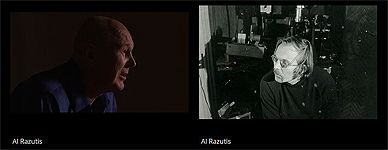
HOME PAGE:
Al
Razutis - Visual Alchemy WEB SITE
